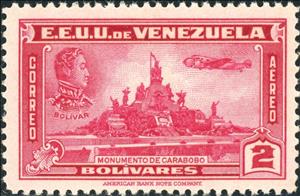Stamp: Simón Bolívar and Carabobo Monument (Venezuela 1940)
Simón Bolívar and Carabobo Monument (Venezuela 1940)
30 March (Venezuela ) within release Independence party goes into circulation Stamp Simón Bolívar and Carabobo Monument face value 2 Venezuelan bolívar
| Stamp Simón Bolívar and Carabobo Monument in catalogues | |
|---|---|
| Michel: | Mi: VE 338 |
| Yvert et Tellier: | Yt: VE PA136 |
Stamp is horizontal format.
Also in the issue Independence party:
- Stamp - Diego B. Urbaneja face value 5;
- Stamp - Diego B. Urbaneja face value 37½;
- Stamp - Diego B. Urbaneja face value 40;
- Stamp - Diego B. Urbaneja face value 50;
- Stamp - Diego B. Urbaneja face value 1;
- Stamp - Simón Bolívar and Carabobo Monument face value 40;
- Stamp - Simón Bolívar and Carabobo Monument face value 25;
- Stamp - Diego B. Urbaneja face value 15;
- Stamp - Diego B. Urbaneja face value 3;
- Stamp - Simón Bolívar and Carabobo Monument face value 2;
Stamp Simón Bolívar and Carabobo Monument it reflects the thematic directions:
An aircraft (pl. aircraft) is a vehicle that is able to fly by gaining support from the air. It counters the force of gravity by using either static lift or the dynamic lift of an airfoil, or, in a few cases, direct downward thrust from its engines. Common examples of aircraft include airplanes, rotorcraft (including helicopters), airships (including blimps), gliders, paramotors, and hot air balloons.Part 1 (Definitions and Abbreviations) of Subchapter A of Chapter I of Title 14 of the U. S. Code of Federal Regulations states that aircraft "means a device that is used or intended to be used for flight in the air."
Famous People refers to the fame and public attention accorded by the mass media to individuals or groups or, occasionally, animals, but is usually applied to the persons or groups of people (celebrity couples, families, etc.) themselves who receive such a status of fame and attention. Celebrity status is often associated with wealth (commonly referred to as fame and fortune), while fame often provides opportunities to make money.
A freedom fighter is a person engaged in a resistance movement against what they believe to be an oppressive and illegitimate government.
A head of state (or chief of state) is the public persona that officially represents the national unity and legitimacy of a sovereign state. In some countries, the head of state is a ceremonial figurehead with limited or no executive power, while in others, the head of state is also the head of government. In countries with parliamentary governments, the head of state is typically a ceremonial figurehead that does not actually guide day-to-day government activities and may not be empowered to exercise any kind of secular political authority (e.g., Queen Elizabeth II as Head of the Commonwealth). In countries where the head of state is also the head of government, the president serves as both a public figurehead and the actual highest ranking political leader who oversees the executive branch (e.g., the President of the United States).
A man is an adult male human. Prior to adulthood, a male human is referred to as a boy (a male child or adolescent).
A monument is a type of structure that was explicitly created to commemorate a person or event, or which has become relevant to a social group as a part of their remembrance of historic times or cultural heritage, due to its artistic, historical, political, technical or architectural importance. Examples of monuments include statues, (war) memorials, historical buildings, archaeological sites, and cultural assets. If there is a public interest in its preservation, a monument can for example be listed as a UNESCO World Heritage Site. The Palgrave Encyclopedia of Cultural Heritage and Conflict gives the next definition of monument:





